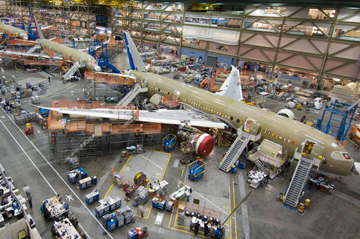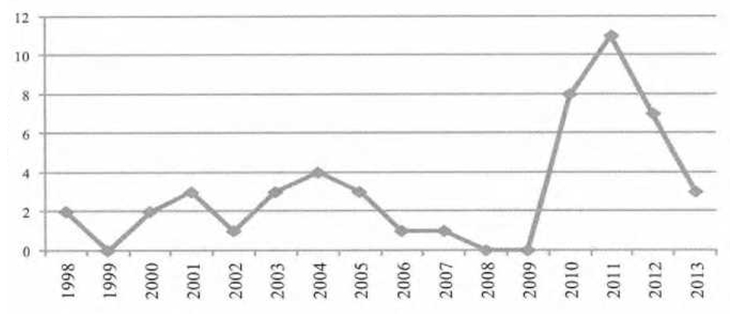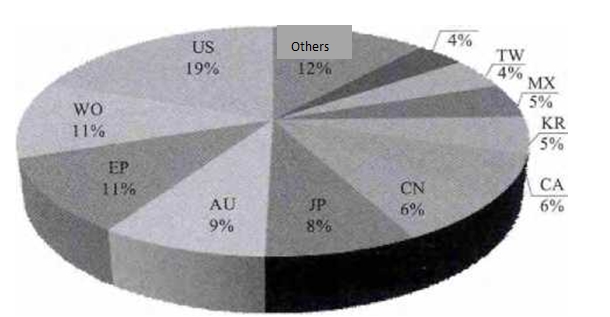
Profile of Patents
Layout of RTI
RTI started its
global patents application quite early; however, it has not been
very keen in pursuing the patents application among all those
years. It seems that the company has taken no account of
Chinese market as all of its patents in China were invalid. By Sep. 2014, there
were 33 patents all together regarded to the field of titanium alloy for RTI.
As we can see in the Fig. 3, RTI applied its first patent as early as 1966, but
the curve of the application did not turn to be smooth and steady until the
year of 1987.The period
ranged from the end of 1970s to the end of 1980s was a vacancy for patents
layout, and the company didn’t seem very
active in the patents application, except in
the year of 2004. The inactive layout strategy resulted in a low quantity
in patents application.
Fig.3 Global
Patents Application of RTI over the Years
In terms of technology
layout of patents application, RTI paid
more attention to the patents regarded to titanium alloy, titanium materials,
and the processing techniques of titanium. Among the patents layout of titanium
alloy, the company placed more emphasis on the titanium processing techniques
as there were seven patents applications in terms of the field of casting,
especially the continuous casting technique. In terms of the application areas,
RTI has not only laid its patents layout in the field of aviation, but also in
the field of sports apparatus, for example, the golf clubs. It’s worth noting
that RTI has placed no patents layout yet in the field of titanium sponge that
belongs to the upstream of the industry.
2. Strategies and Characteristics of RTI Patents Layout
RTI adopted
sugar-coated patents layout together with the roadblock-pattern, so as to
improve the degree of difficulty for competitors entering the technical fields.
Take patents
layout of continuous casting technique as an example, RTI put forward several
peripheral technologies regarded to continuous casting methods including the
preheating methods for continuous casting, temperature control methods and
devices in the continuous casting furnace, and the sealing casting methods in
the continuous casting devices within three years. It has formed a
patents network consisting of core patents and peripheral patents, and thus to
effectively improve the difficulty for competitors entering the field of continuous
casting.
Similarly, the
hot forming technology of titanium bar has also been formed a
small-scale roadblock-pattern layout of patents. RTI has
successfully extended the network of continuous casting patents to the hot
forming technology of titanium bar through two patents of the continuous
casting techniques and equipment of the long-sized casting.
In the future,
RTI would still concern the constructing of core patents complex including the
processing techniques of titanium alloy of midstream industry chain, continuous
casting techniques, and the titanium bar processing techniques.
There’s a wide
range of processing techniques applied by RTI. In 1990s, the company proposed
de-oxidation
method for fire-resistant materials and the method of removing oxide layer on
titanium ingoting; in 2002, it
proposed the method for melting and casting titanium alloy and the method for
melting the titanium alloy through plasma arc and electron beam; after 2006,
RTI has formed a complete set of patents complex concerned continuous casting
techniques on the basis of the patents of US2006102314 and US2006254746, and it
further proposed the continuous casting techniques and equipment of long-sized
casting represented by titanium bar with the aid of hot forming technology of
titanium bar of 2007.
With the help
of commercial acquisitions and asset sale, RTI adjusted the patent portfolio
and completed the patents screen circle of the corresponding technologies. The
company expanded the production and improving the processing ability by the
means of acquisition.
At the same
time, it also implemented strategic adjustment through asset sale. Since 1997,
RTI has acquired Claro Precision Engineering of Canada and Remmele Engeenng of
Aeromet of the UK and marched to the fields of downstream aviation, national
defense, and medical devices with the goal of turning to be an independent
producer of titanium bar. Obviously, acquisition has been an important way for
RTI to consolidate its position as a leading
enterprise.
RTI
established six companies all together through acquisition and joint-venturing,
among which the patents of Dynamet Technology and Osbom has effectively
perfected the patents layout of RTI. Dynamet applied three patents in the field
of titanium-tungsten alloy and thus constituted a complex with the core
technology of powder metallurgy processing of titanium-tungsten alloy. Besides,
Dynamet further proposed patents of the manufacturing methods of the
fine-grained titanium alloy and oxygen-enriched TC4 alloy. With the help of the
acquisition on June 2014, RTI has successfully involved the patents concerned
titanium alloy, including the manufacturing technique of titanium-tungsten
alloy, into its patents layout, which to some degree has made up the patents
vacancy in the field of titanium alloy.
Analysis on Patents
Layout of ATI
1. Profile of Patents Layout of ATI
Although ATI started its global patents application
quite late, it has been very active in the patents application. It was not
until 1998 ATI applied its first patent, which was quite late compared with the
other two magnates. With the commissioning of its titanium sponge factory in
Raleigh, the upstream supply channel of ATI has been guaranteed, the patents application
of ATI has hugely increased since 2010. In 2011, the annually applications
mounted to the record high of 11. The active attitude of ATI on patents application
helped the company to achieve a Corner Overtaking in the area of patents. By
September 2014, ATI applied 49 patents in the field of global titanium alloy
all together (Fig. 4).
Fig. 4 Global
Patents Application of ATI over the Years

The patents
layout of ATI is characterized by its wide target area and uniform market
distribution. As we can see from Fig. 5, most of the patents layout of ATI distributed
in the US, Europe, Australia, Japan, China, Canada, and South Korea. And in
terms of the quantity of patents application, apart from the US, it was similar
among the countries and areas. And a large proportion of the application of ATI
was applied in the way of PCT.
It’s worth
mentioning that most of the applications of ATI in China have already been
audited but yet to wind up. The applications in the authorization and
maintenance status still have 7 to 10 years to expire, which means ATI is still
in the exploration stage in developing Chinese market.
Fig. 5 Distribution
of ATI Global Patents Application

2. Strategies and Characteristics of ATI Patents
Layout
With the
strong independence among every single patent and few researches on sustaining
technologies, the network of the patents layout of ATI has not fully
established yet. Although ATI ranked the first in terms of the quantity of the patent applications among all
three magnates, the company has not established a complete network of patents
layout yet.
Similar to
Timet and RTI, ATI adjusted its asset allocation through acquisition and asset sale. ATI adjusted it allocation of patents
resource in the process of acquisition for three times all together. In 2006, Dynamic
Flowform put forward a metal spinning method for processing a-p titanium alloy
under ordinary temperature in one of its patents, by which it can not only
produce net forming or near-net forming titanium alloy tubing but also reduce
the waste of raw materials and cost.
In another
application of Dynamic Flowform in 2013, which was US847954, the company
proposed a centrifugal casting method for processing seamless pipe. By the
means of acquisition, ATI received the core technologies of the field of metal
spinning of tubing of Dynamic Flowform.
*This article is edited and translated by
CCM. The original version comes from China Invention & Patent.
About
CCM:
CCM is the leading market intelligence
provider for China’s agriculture, chemicals, food & ingredients and life
science markets. Founded in 2001, CCM offers a range of data and content
solutions, from price and trade data to industry newsletters and customized
market research reports. Our clients include Monsanto, DuPont, Shell, Bayer,
and Syngenta. CCM is a brand of Kcomber Inc.
For more information about CCM, please
visit www.cnchemicals.com or get in
touch with us directly by emailing econtact@cnchemicals.com or calling +86-20-37616606.